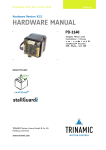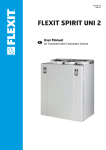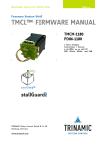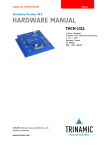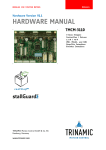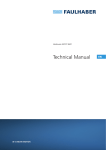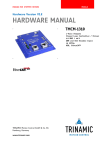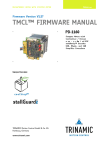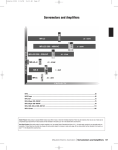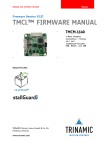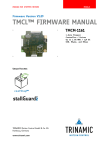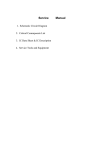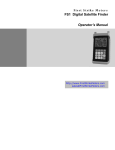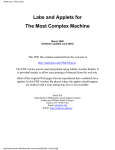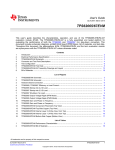Download HARDWARE MANUAL
Transcript
MECHATRONIC DRIVE WITH STEPPER MOTOR PANdrive Hardware Version V1.1 HARDWARE MANUAL + + TMCM-1180 PD86-1180 1-Axis Stepper Controller / Driver 5.5A RMS/ 24 or 48V DC USB, RS232, RS485, and CAN + TRINAMIC Motion Control GmbH & Co. KG Hamburg, Germany www.trinamic.com + TMCM-1180 and PD86-1180 Hardware Manual (V1.05 / 2013-JUL-26) Table of Contents 2 3 4 Features ........................................................................................................................................................................... 3 Order Codes ................................................................................................................................................................... 4 Mechanical and Electrical Interfacing ..................................................................................................................... 5 4.1 TMCM-1180 Dimensions and Mounting Holes ............................................................................................. 5 4.2 PD86-1180 Dimensions and Motor Specifications ...................................................................................... 6 4.2.1 Dimensions of PD86-3-1180 ........................................................................................................................ 6 4.2.2 Motor Specifications of QSH8618-96-55-700 ........................................................................................... 7 4.2.3 Torque Figure of QSH8618-96-55-700 ....................................................................................................... 8 4.3 Connectors of TMCM-1180 ................................................................................................................................. 9 4.3.1 Power Connector ......................................................................................................................................... 10 4.3.2 Serial Communication Connector ........................................................................................................... 12 4.3.3 USB Connector .............................................................................................................................................. 12 4.3.4 Output Connector ........................................................................................................................................ 13 4.3.5 Input Connector ........................................................................................................................................... 14 4.3.6 Step/Direction Connector .......................................................................................................................... 16 4.3.7 Encoder Connector ...................................................................................................................................... 17 4.3.8 Motor Connector and Specifications ...................................................................................................... 18 5 Jumpers ......................................................................................................................................................................... 19 5.1 RS485 Bus Termination .................................................................................................................................... 19 5.2 CAN Bus Termination........................................................................................................................................ 19 6 Operational Ratings ................................................................................................................................................... 20 7 Functional Description .............................................................................................................................................. 21 7.1 System Architecture .......................................................................................................................................... 21 7.1.1 Microcontroller ............................................................................................................................................. 21 7.1.2 EEPROM ........................................................................................................................................................... 21 7.1.3 Motion Controller ........................................................................................................................................ 21 7.1.4 Stepper Motor Driver .................................................................................................................................. 22 7.1.5 sensOstep Encoder ...................................................................................................................................... 22 8 TMCM-1180 Operational Description ..................................................................................................................... 23 8.1 Calculation: Velocity and Acceleration vs. Microstep and Fullstep Frequency ................................ 23 9 TMCL ............................................................................................................................................................................... 25 10 CANopen ....................................................................................................................................................................... 25 11 Life Support Policy ..................................................................................................................................................... 26 12 Revision History .......................................................................................................................................................... 27 12.1 Document Revision ........................................................................................................................................... 27 12.2 Hardware Revision ............................................................................................................................................ 27 13 References..................................................................................................................................................................... 27 www.trinamic.com 2 TMCM-1180 and PD86-1180 Hardware Manual (V1.05 / 2013-JUL-26) 2 3 Features The PD86-1180 is a full mechatronic solution with state of the arte feature set. It is highly integrated and offers a convenient handling. The PD86-1180 consists of a NEMA 34 (flange size 86mm) stepper motor, controller/driver electronics and integrated encoder. The TMCM-1180 is an intelligent stepper motor controller/driver module featuring the new outstanding coolStep™ technology for sensorless load dependent current control. This allows energy efficient motor operation. With the advanced stallGuard2™ feature the load of the motor can be detected with high resolution. The module is designed to be mounted directly on an 86mm flange QMot stepper motor. MAIN CHARACTERISTICS Electrical data Supply voltage: +24V DC or +48V DC nominal Motor current: up to 5.5A RMS (programmable) PANdrive motor Two phase bipolar stepper motor with up to 5.5A RMS nom. coil current Holding torque: 7Nm Encoder Integrated sensOstep magnetic encoder (max. 256 increments per rotation) e.g. for step-loss detection under all operating conditions and positioning Integrated motion controller Motion profile calculation in real-time (TMC428/429 motion controller) On the fly alteration of motor parameters (e.g. position, velocity, acceleration) High performance microcontroller for overall system control and serial communication protocol handling Bipolar stepper motor driver Up to 256 microsteps per full step High-efficient operation, low power dissipation Dynamic current control Integrated protection stallGuard2 feature for stall detection coolStep feature for reduced power consumption and heat dissipation Interfaces inputs for stop switches (left and right) and home switch general purpose inputs and 2 general purpose outputs USB, RS232, RS485 and CAN (2.0B up to 1Mbit/s) communication interfaces Safety features Shutdown input. The driver will be disabled in hardware as long as this pin is left open or shorted to ground Separate supply voltage inputs for driver and digital logic – driver supply voltage may be switched off externally while supply for digital logic and therefore digital logic remains active Software Available with TMCL™ or CANopen Standalone TMCL operation or remote controlled operation Program memory (non volatile) for up to 2048 TMCL commands PC-based application development software TMCL-IDE available for free CANopen: CiA 301 + CiA 402 (homing mode, profile position mode and velocity mode) supported Please see separate TMCL and CANopen Firmware Manuals for additional information www.trinamic.com TMCM-1180 and PD86-1180 Hardware Manual (V1.05 / 2013-JUL-26) 3 4 Order Codes Cables are not included. Add the appropriate cable loom to your order if required. Order code TMCM-1180 (-option) PD86-3-1180 (-option) Description TMCM-1180 with coolStep, sensOstep PD86-3-1180 with coolStep, sensOstep, 7.0 Nm Table 3.1 PANdrive or module order codes Option -TMCL -CANopen Firmware TMCL firmware CANopen firmware Table 3.2 Options for order codes Component part TMCM-1180-CABLE Description Cable loom for module and PANdrive Table 3.3 Order codes for component parts www.trinamic.com Dimensions [mm³] 85.9 x 85.9 x 21.5 85.9 x 85.9 x 118.5 TMCM-1180 and PD86-1180 Hardware Manual (V1.05 / 2013-JUL-26) 4 5 Mechanical and Electrical Interfacing 4.1 TMCM-1180 Dimensions and Mounting Holes The dimensions of the controller/driver board (TMCM-1180) are approx. 86mm x 86mm in order to fit to the back side of the 86mm stepper motor. The TMCM-1180 is 21.5mm high without matching connectors. There are four mounting holes for M4 screws. 85.9 4.55 67.45 8 2 8 2 R5.9 M4 TMCM-1180 85.9 81.35 72 67.45 18.45 13.9 4.55 13.9 18.45 72 81.35 Figure 4.1 Dimensions of TMCM-1180 and mounting holes www.trinamic.com TMCM-1180 and PD86-1180 Hardware Manual (V1.05 / 2013-JUL-26) 6 4.2 PD86-1180 Dimensions and Motor Specifications The PD86-1180 includes the TMCM-1180 stepper motor controller/driver electronic module, a magnetic encoder based on sensOstep technology and an 86mm flange size bipolar hybrid stepper motor. 4.2.1 Dimensions of PD86-3-1180 96 4.1 22.5 max 1.4 17 1.1 25 73.02±0.05 12.7 11.6 85.85 31.75±1 1.52 8.38 69.5±0.2 85.9 73.02±0.05 11.6 12.7 4 x ø 5.5 400 min. Figure 4.2 PD86-3-1180 dimensions www.trinamic.com 85.9 69.5±0.2 TMCM-1180 and PD86-1180 Hardware Manual (V1.05 / 2013-JUL-26) 4.2.2 Motor Specifications of QSH8618-96-55-700 Specifications Units Wiring Rated Voltage V Rated Phase Current (nominal) A Phase Resistance at 20°C Ω Phase Inductance (typ.) mH Holding Torque (typ.) Nm Detent Torque Nm Rotor Inertia gcm2 Weight (Mass) Kg Insulation Class Insulation Resistance Ω Dialectic Strength (for one VAC minute) Connection Wires N° Max applicable Voltage V Step Angle ° Step angle Accuracy % Flange Size (max.) mm Motor Length (max.) mm Axis Diameter mm Axis Length (visible part, typ.) mm Axis D-cut (1.1mm depth) mm Shaft Radial Play (450g load) mm Shaft Axial Play (450g load) mm Maximum Radial Force N (20 mm from front flange) Maximum Axial Force N Ambient Temperature °C Temp Rise °C (rated current, 2 phase on) QSH8618-96-55-700 2.56 5.5 0.45 4.5 7.0 2700 2.8 B 100M 500 4 140 1.8 5 85.85 96 12.7 31.75 25.0 0.02 0.08 220 60 -20… +50 max. 80 Table 4.1 Motor specifications of QSH8618-96-55-700 www.trinamic.com 7 TMCM-1180 and PD86-1180 Hardware Manual (V1.05 / 2013-JUL-26) 8 4.2.3 Torque Figure of QSH8618-96-55-700 The torque figure details the motor torque characteristics for full step operation in order to allow simple comparison. For full step operation there are always a number of resonance points (with less torque) which are not depicted. These will be minimized by microstep operation. Testing conditions: 48V; 5,5A Torque 6 Full step [Nm] 5 4 3 2 1 0 100 1000 Figure 4.3 QSH8618-96-55-700 speed vs. torque characteristics www.trinamic.com 10000 Speed [Pps] TMCM-1180 and PD86-1180 Hardware Manual (V1.05 / 2013-JUL-26) 9 4.3 Connectors of TMCM-1180 The controller/driver board of the PD86-1180 offers eight connectors including the motor connector which is used internally for attaching the motor coils to the electronics. In addition to the power connector there are two connectors for serial communication (one for mini-USB and one for RS232/RS485/CAN) and two connectors for additional input and output signals. Further there is one connector for Step/Direction and another for the encoder. The output connector offers two general purpose outputs, one power supply voltage output, and one hardware shutdown input. Leaving the shutdown input open or tying it to ground will disable the motor driver stage in hardware. For operation, this input should be tied to the supply voltage. The input connector offers two inputs for stop switches (left and right), one home switch input, two general purpose inputs and one connection to the system or signal ground. Encoder Step/Dir Input Output 1 1 1 1 Serial communication 1 Power USB 1 1 Motor Figure 4.4 Overview connectors Label Power Motor Mini-USB Connector type Mating connector type JST JST JST JST Connector housing JST: VHR-4N Contacts JST: BVH-21T-P1.1 Connector housing JST: VHR-4N Contacts JST: BVH-21T-P1.1 B4P-VH VH series, 4 pins, 3.96mm pitch B4P-VH VH series, 4 pins, 3.96mm pitch Molex 500075-1517 Mini USB Type B vertical receptacle Any standard mini-USB plug Connector housing CVIlux: CI01085000-A Contacts CVIlux: CI01T011PE0-A Serial communication CI0108P1VK0-LF CVIlux CI01 series, 8 pins, 2mm pitch or Connector housing JST: PHR-8 Contacts JST: SPH-002T-P0.5S Wire: 0.22mm2 www.trinamic.com TMCM-1180 and PD86-1180 Hardware Manual (V1.05 / 2013-JUL-26) Label Connector type 10 Mating connector type Connector housing CVIlux: CI01065000-A Contacts CVIlux: CI01T011PE0-A CI0106P1VK0-LF CVIlux CI01 series, 6 pins, 2mm pitch Inputs or Connector housing JST: PHR-6 Contacts JST: SPH-002T-P0.5S Wire: 0.22mm2 Connector housing CVIlux: CI01045000-A Contacts CVIlux: CI01T011PE0-A CI0104P1VK0-LF CVIlux CI01 series, 4 pins, 2mm pitch Outputs or Connector housing JST: PHR-4 Contacts JST: SPH-002T-P0.5S Wire: 0.22mm2 Connector housing CVIlux: CI01055000-A Contacts CVIlux: CI01T011PE0-A CI0105P1VK0-LF CVIlux CI01 series, 5 pins, 2mm pitch Encoder or Connector housing JST: PHR-5 Contacts JST: SPH-002T-P0.5S Wire: 0.22mm2 Connector housing CVIlux: CI01045000-A Contacts CVIlux: CI01T011PE0-A CI0104P1VK0-LF CVIlux CI01 series, 4 pins, 2mm pitch Step/Dir or Connector housing JST: PHR-4 Contacts JST: SPH-002T-P0.5S Wire: 0.22mm2 Table 4.2 Connectors and mating connectors, contacts and applicable wire 4.3.1 Power Connector This module offers separate power supply inputs for digital logic (pin 2) and driver/power stage (pin 1). Both supply inputs use common ground connections (pin 3 and 4). This way, power supply for the driver stage may be switched off while still maintaining position and status information when keeping digital logic supply active. +UDRIVER SUPPLY ONLY In case power supply is provided to the power section only, an internal diode will distribute power to the logic section also. So, when separate power supplies are not required it is possible to just use pin 1 and 4 for powering the module. 1 4 Pin Label Description Module + driver stage power supply input (nom. +48V DC) (Optional) separate digital logic power supply input (nom. +48V DC) 1 +UDriver 2 +ULogic 3 GND Module ground (power supply and signal ground) 4 GND Module ground (power supply and signal ground) Table 4.3 Connector for power supply To ensure reliable operation of the unit, the power supply has to have a sufficient output capacitor and the supply cables should have a low resistance, so that the chopper operation does not lead to an increased power supply ripple directly at the unit. Power supply ripple due to the chopper operation should be kept at a maximum of a few 100mV. www.trinamic.com TMCM-1180 and PD86-1180 Hardware Manual (V1.05 / 2013-JUL-26) HINTS FOR POWER SUPPLY - keep power supply cables as short as possible use large diameters for power supply cables CAUTION! Add external power supply capacitors! It is recommended to connect an electrolytic capacitor of significant size (e.g. 4700 µF / 63 V) to the power supply lines next to the PD-1180 especially if the distance to the power supply is large (i.e. more than 2-3m)! In larger systems a zener diode circuitry might be required in order to limit the maximum voltage when the motor is operated at high velocities. Rule of thumb for size of electrolytic capacitor: In addition to power stabilization (buffer) and filtering this added capacitor will also reduce any voltage spikes which might otherwise occur from a combination of high inductance power supply wires and the ceramic capacitors. In addition it will limit slewrate of power supply voltage at the module. The low ESR of ceramic-only filter capacitors may cause stability problems with some switching power supplies. Do not connect or disconnect motor during operation! Motor cable and motor inductivity might lead to voltage spikes when the motor is disconnected / connected while energized. These voltage spikes might exceed voltage limits of the driver MOSFETs and might permanently damage them. Therefore, always disconnect power supply before connecting / disconnecting the motor. Keep the power supply voltage below the upper limit of 55V! Otherwise the driver electronics will seriously be damaged! Especially, when the selected operating voltage is near the upper limit a regulated power supply is highly recommended. Please see also chapter 6 (operating values). There is no reverse polarity protection! The module will short any reversed supply voltage due to internal diodes of the driver transistors. www.trinamic.com 11 TMCM-1180 and PD86-1180 Hardware Manual (V1.05 / 2013-JUL-26) 12 4.3.2 Serial Communication Connector A 2mm pitch 8 pin connector is used for serial communication. With this connector the module supports RS232, RS485 and CAN communication. 1 8 Pin 1 2 3 4 5 6 7 8 Label RS232_TxD RS232_RxD GND CAN_H CAN_L GND RS485+ RS485- Description RS232 transmit data RS232 receive data Module ground (system and signal ground) CAN_H bus line (dominant high) CAN_L bus line (dominant low) Module ground (system and signal ground) RS485 non-inverted bus signal RS485 inverted bus signal Table 3.3 Connector for serial communication 4.3.3 USB Connector A 5-pin mini-USB connector is available on board (might depend on assembly option). 1 5 Pin 1 2 3 4 5 Table 3.4 Mini USB connector www.trinamic.com Label VBUS DD+ ID GND Description +5V power Data – Data + Not connected ground TMCM-1180 and PD86-1180 Hardware Manual (V1.05 / 2013-JUL-26) 13 4.3.4 Output Connector A 2mm pitch 4 pin connector is used for connecting the two general purpose outputs and the driver stage hardware shutdown input pin to the unit. In order to enable the motor driver stage connect /Shutdown (pin 2) to +ULogic (pin 1)! 1 4 Pin Label 1 +ULogic 2 /Shutdown 3 OUT_0 4 OUT_1 Description Module digital logic power supply – connected to pin 2 of power supply connector /Shutdown input – has to be connected to power supply (e.g. pin 1 of this connector) in order to enable driver. Connecting this input to ground or leaving it unconnected will disable driver stage Open collector output with integrated freewheeling diode, +24V compatible Open collector output with integrated freewheeling diode, +24V compatible Table 4.4 Output / /Shutdown connector supply voltage e.g. +24V supply voltage e.g. +24V supply voltage e.g. +24V galvanic isolation freewheeling diode integrated on-board opto-coupler GPO GPO GPO Figure 4.5 Possible circuits for GPO +ULogic +ULogic OUT_0 OUT_1 OUT_0 1k00 OUT_1 1k00 GND GND Figure 4.6 Internal circuit of the outputs www.trinamic.com TMCM-1180 and PD86-1180 Hardware Manual (V1.05 / 2013-JUL-26) 14 4.3.5 Input Connector A 2mm pitch 6 pin connector is used for connecting general purpose inputs, home and stop switches to the unit. Mating connector housing: PHR-6 Mating connector contacts: SPH-002T-P0.5S 6 1 Pin 1 2 Label IN_0 IN_1 3 STOP_L 4 STOP_R 5 HOME 6 GND Table 4.5 Input / Stop / Home switch connector +24V GPI Figure 4.7 Possible circuit for GPI IN_0/1 22kO +3.3V GND GND 100nF 10kO IN_0/1 GND Figure 4.8 Internal circuit of the inputs www.trinamic.com Description General purpose input, +24V compatible General purpose input, +24V compatible Left stop switch input, +24V compatible, programmable internal pull-up (1k to +5V) Right stop switch input, +24V compatible, programmable internal pull-up (1k to +5V) Home switch input, +24V compatible, programmable internal pull-up (1k to +5V) Module ground (system and signal ground) TMCM-1180 and PD86-1180 Hardware Manual (V1.05 / 2013-JUL-26) 15 4.3.5.1 Left and Right Limit Switches The TMCM-1180 can be configured so that a motor has a left and a right limit switch (Figure 4.9). The motor stops when the traveler has reached one of the limit switches. REF _ R _x REF _ L _x motor right stop switch left stop switch traveler Figure 4.9 Left and right limit switches 4.3.5.2 Triple Switch Configuration It is possible to program a tolerance range around the reference switch position. This is useful for a triple switch configuration, as outlined in Figure 4.10. In that configuration two switches are used as automatic stop switches, and one additional switch is used as the reference switch between the left stop switch and the right stop switch. The left stop switch and the reference switch are wired together. The center switch (travel switch) allows for a monitoring of the axis in order to detect a step loss. REF _ L _x REF _ R_x motor left stop reference switch switch right stop switch traveler Figure 4.10 Limit switch and reference switch 4.3.5.3 One Limit Switch for Circular Systems If a circular system is used (Figure 4.11), only one reference switch is necessary, because there are no endpoints in such a system. motor REF _ L _x ref switch eccentric Figure 4.11 One reference switch www.trinamic.com TMCM-1180 and PD86-1180 Hardware Manual (V1.05 / 2013-JUL-26) 16 4.3.6 Step/Direction Connector A 2mm pitch 4 pin connector is used for connecting the Step/Dir interface. 1 4 Pin 1 2 3 4 Label OC_COM OC_EN OC_STEP OC_DIR Description Common supply / opto-coupler (+5V .. +24V) Enable signal Step signal Direction signal Table 4.6 Step/Dir connector C 4k75 EN +3.3V Iconst = 8mA K E GND Iconst = 8mA 4k75 OC_EN 4k75 A OC_COM DIR OC_DIR OC_STEP STEP GND Figure 4.12 Internal circuit of the Step/Dir interface www.trinamic.com TMCM-1180 and PD86-1180 Hardware Manual (V1.05 / 2013-JUL-26) 17 4.3.7 Encoder Connector A 2mm pitch 5 pin connector is used for connecting the Encoder. Mating connector housing: PHR-5 Mating connector contacts: SPH-002T-P0.5S 1 Pin 1 2 3 4 5 5 Label ENC_A ENC_B ENC_N GND +5V_output Description Encoder A-channel Encoder B-channel Encoder N-channel Power and signal ground +5V output for encoder power supply (max. 100mA) Table 4.7 Encoder connector +5V +5V +5V GND GND GND 2k2 2k2 2k2 0.1A +5V 1 ENC_A 2k2 2k2 100pF 2k2 GND 1 1 ENC_B ENC_N GND Figure 4.13 Internal circuit of encoder interface Keep the electronics free of (metal) particles! The encoder uses a magnet at the end of the motor axis in order to monitor position. The magnet naturally attracts especially tiny metal particles. These particles might be held on the top side of the PCB and even worse – start moving in accordance with the rotating magnetic field as soon as the motor starts moving. This might lead to shorts of electronic contacts / wires on the board and totally erratic behavior of the module! Use compressed air for cleaning the module if necessary. www.trinamic.com TMCM-1180 and PD86-1180 Hardware Manual (V1.05 / 2013-JUL-26) 18 4.3.8 Motor Connector and Specifications A 3.96mm pitch 4 pin connector is used for motor connection. Both motor coil windings (bipolar stepper motor) are connected to this connector. Mating connector housing: VHR-4N Mating connector contacts: BVH-21T-P1.1 1 4 Table 4.8 Connector for motor www.trinamic.com Pin Label Description 1 2 3 4 OA1 OA2 OB1 OB2 Motor Motor Motor Motor coil coil coil coil A A B B TMCM-1180 and PD86-1180 Hardware Manual (V1.05 / 2013-JUL-26) 5 19 Jumpers Most settings of the board are done through the software. Nevertheless, a few jumpers are available for configuration. CAN bus termination RS485 bus termination Figure 5.1 RS485 and CAN bus termination 5.1 RS485 Bus Termination The board includes a 120 Ohm resistor for proper bus termination of the RS485 interface. When this jumper is closed, the resistor will be placed between the two differential bus lines RS485+ and RS485-. 5.2 CAN Bus Termination The board includes a 120 Ohm resistor for proper bus termination of the CAN interface. When this jumper is closed, the resistor will be placed between the two differential bus lines CAN_H and CAN_L. www.trinamic.com TMCM-1180 and PD86-1180 Hardware Manual (V1.05 / 2013-JUL-26) 6 20 Operational Ratings The operational ratings shown below should be used as design values. In no case should the maximum values been exceeded during operation. Symbol Parameter +UDriver / +ULogic Power supply voltage for operation ICOIL_peak Motor coil current for sine wave peak (chopper regulated, adjustable via software) ICOIL_RMS Continuous motor current (RMS) ISUPPLY Power supply current TENV Environment temperature at rated current (no forced cooling required) Min 18 0 Typ 24 or 48 0 << ICOIL -20 Max 55 7.8 Unit V DC A 5.5 1.4 * ICOIL +50*) A A °C Table 6.1 General operational ratings of the module *) The controller driver electronics has been tested inside a climate chamber running at full current (5.5A RMS) for 30min without air convection at 50°C environmental temperature. The motor might heat up well above 50°C when running at full current without proper cooling. This might substantially increase the environmental temperature for the electronics. When using the coolStep operation mode, the actual current might be substantially less than programmed max. current producing and temperature. www.trinamic.com TMCM-1180 and PD86-1180 Hardware Manual (V1.05 / 2013-JUL-26) 7 21 Functional Description In figure 7.1 the main parts of the PD86-1180 are shown. The PANdrive mainly consists of the µC (connected to the EEPROM TMCL memory), the TMC428/429 motion controller, the TMC262A-PC power driver with its energy efficient coolStep feature, the external MOSFET driver stage, the QSH8618 stepper motor, and the integrated sensOstep encoder. Alternatively it is possible to connect an external encoder. Nominal supply voltages are 24VDC or 48VDC. TMCL™ Memory PD86-1180 Stop Switches CAN RS232 +5V µC RS485 Motion Controller USB add. I/Os 4 Energy Power Efficient Driver Driver with TMC262 coolStep™ Step/ Dir MOSFET Driver Stage Step Alternative: external Encoder Motor ABN ABN sensOstep™ Encoder 18… 55V DC TMCM-1180 Figure 7.1 Main parts of the PD86-1180 7.1 System Architecture The TMCM-1180 integrates a microcontroller with the TMCL (Trinamic Motion Control Language) operating system. The motion control real-time tasks are realized by the TMC428/429. 7.1.1 Microcontroller On this module, the Atmel AT91SAM7X256 is used to run the TMCL operating system and to control the TMC428/429. The CPU has 256KB flash memory and a 64KB RAM. The microcontroller runs the TMCL (Trinamic Motion Control Language) operating system which makes it possible to execute TMCL commands that are sent to the module from the host via the RS232, RS485, USB, or CAN interface. The microcontroller interprets the TMCL commands and controls the TMC428/429 which executes the motion commands. In addition it is connected with the encoder interface and processes the inputs. The flash ROM of the microcontroller holds the TMCL operating system. The TMCL operating system can be updated via the RS232 interface or via the CAN interface. Use the TMCL-IDE to do this. 7.1.2 EEPROM To store TMCL programs for stand-alone operation the TMCM-1180 module is equipped with a 16kByte EEPROM attached to the microcontroller. The EEPROM can store TMCL programs consisting of up to 2048 TMCL commands. The EEPROM is also used to store configuration data. 7.1.3 Motion Controller The TMC428/429 is a high-performance stepper motor control IC and can control up to three 2-phase-steppermotors. Motion parameters like speed or acceleration are sent to the TMC428/429 via SPI by the microcontroller. Calculation of ramps and speed profiles are done internally by hardware based on the target motion parameters. www.trinamic.com TMCM-1180 and PD86-1180 Hardware Manual (V1.05 / 2013-JUL-26) 22 7.1.4 Stepper Motor Driver The TMC262A-PC is an energy efficient high current high precision microstepping driver IC for bipolar stepper motors. This driver on the TMCM-1180 module is a special version of the TMC262 power driver for PANdrives with QSH8618 motors. mechanical load stallGuard2 reading motor current Its unique high resolution sensorless load detection stallGuard2 is used for a special integrated load dependent current control feature called coolStep. The ability to read out the load and detect an overload makes the TMC262 an optimum choice for drives where a high reliability is desired. The TMC262 can be driven with step/direction signals as well as by serial SPI™. current setting CS (upper limit) motor current reduction area SEMAX+SEMIN+1 SEMIN ½ or ¼ CS (lower limit) motor current increment area 0=maximum load load angle optimized Zeit slow current reduction due to reduced motor load load angle optimized current increment due to increased load stall possible load angle optimized Figure 7.2 Motor current control via coolStep adapts motor current to motor load The coolStep current regulator allows to control the reaction of the driver to increasing or decreasing load. The internal regulator uses two thresholds to determine the minimum and the maximum load angle for optimum motor operation. The current increment speed and the current decrement speed can be adapted to the application. Additionally, the lower current limit can be set in relation to the upper current limit set by the current scale parameter CS. 7.1.5 sensOstep Encoder The sensOstep encoder used in this unit is based on a magnetic angular position encoder system with low resolution. It consists of a small magnet positioned at the back end of a stepper motor axis and a Hallsensor IC with integrated digital signal processing (e.g. for automatic gain control, temperature compensation etc.) placed above the magnet on the back side of a motor mounted printed circuit board. The encoder offers a resolutions of 8 bit (256 steps) per revolution which is completely sufficient for detecting step losses with a standard 1.8° stepper motors. www.trinamic.com TMCM-1180 and PD86-1180 Hardware Manual (V1.05 / 2013-JUL-26) 8 23 TMCM-1180 Operational Description 8.1 Calculation: Velocity and Acceleration vs. Microstep and Fullstep Frequency The values of the parameters sent to the TMC428/429 do not have typical motor values like rotations per second as velocity. But these values can be calculated from the TMC428/429-parameters as shown in this section. PARAMETERS FOR THE Signal fCLK velocity a_max pulse_div ramp_div Usrs TMC428/429 Description clock-frequency maximum acceleration Divider for the velocity. The higher the value is, the less is the maximum velocity default value = 0 Divider for the acceleration. The higher the value is, the less is the maximum acceleration default value = 0 microstep-resolution (microsteps per fullstep = 2usrs) Range 16 MHz 0… 2047 0… 2047 0… 13 0… 13 0… 7 Table 8.1 TMC428/429 velocity parameters The microstep-frequency of the stepper motor is calculated with usf [ Hz] f CLK [ Hz] velocity 2 pulse_ div 2048 32 with usf: microstep-frequency To calculate the fullstep-frequency from the microstep-frequency, the microstep-frequency must be divided by the number of microsteps per fullstep. fsf [ Hz] usf [ Hz] 2usrs with fsf: fullstep-frequency The change in the pulse rate per time unit (pulse frequency change per second – the acceleration a) is given by f CLK a max 2 a 2 pulse_ div ramp _ div 29 This results in acceleration in fullsteps of: af a 2 usrs www.trinamic.com with af: acceleration in fullsteps TMCM-1180 and PD86-1180 Hardware Manual (V1.05 / 2013-JUL-26) EXAMPLE Signal f_CLK velocity a_max pulse_div ramp_div usrs msf 16 MHz 1000 122070.31 Hz 21 2048 32 fsf [ Hz] a value 16 MHz 1000 1000 1 1 6 122070.31 1907.34 Hz 26 (16Mhz ) 2 1000 MHz 119.21 11 29 s 2 MHz s 1.863 MHz 6 s 2 119.21 af Calculation of the number of rotations: A stepper motor has e.g. 72 fullsteps per rotation. RPS RPM fsf 1907.34 26.49 fullsteps per rotation 72 fsf 60 1907.34 60 1589.46 fullsteps per rotation 72 www.trinamic.com 24 TMCM-1180 and PD86-1180 Hardware Manual (V1.05 / 2013-JUL-26) 9 25 TMCL TMCL, the TRINAMIC Motion Control Language, is described in separate documentations, which refer to the specific products (e.g. TMCM-1180 TMCL Firmware Manual). The manuals are provided on www.trinamic.com. Please refer to these source for updated data sheets and application notes. 10 CANopen The TMCM-1180 module should also be used with the CANopen protocol in future versions. For this purpose, a special CANopen firmware is under development. Please contact TRINAMIC if you are interested in this option. www.trinamic.com TMCM-1180 and PD86-1180 Hardware Manual (V1.05 / 2013-JUL-26) 11 Life Support Policy TRINAMIC Motion Control GmbH & Co. KG does not authorize or warrant any of its products for use in life support systems, without the specific written consent of TRINAMIC Motion Control GmbH & Co. KG. Life support systems are equipment intended to support or sustain life, and whose failure to perform, when properly used in accordance with instructions provided, can be reasonably expected to result in personal injury or death. © TRINAMIC Motion Control GmbH & Co. KG 2013 Information given in this data sheet is believed to be accurate and reliable. However neither responsibility is assumed for the consequences of its use nor for any infringement of patents or other rights of third parties, which may result from its use. Specifications are subject to change without notice. All trademarks used are property of their respective owners. www.trinamic.com 26 TMCM-1180 and PD86-1180 Hardware Manual (V1.05 / 2013-JUL-26) 27 12 Revision History 12.1 Document Revision Version Date Author GE – Göran Eggers SD – Sonja Dwersteg Description Initial version New hardware included New engineering detail drawings. Functional and operational descriptions added. New front page, minor changes Minor changes Order codes new, minor changes Changes related to the design. Connector description updated. Chapter 4.3.1 updated. 0.90 0.91 2009-AUG-04 2009-NOV-11 GE GE 1.00 2010-JUN-28 SD 1.01 1.02 1.03 1.04 2011-MAR-21 2011-JUN-08 2011-DEC-02 2012-DEC-15 SD SD SD SD 1.05 2013-JUL-26 SD Table 12.1 Document revision 12.2 Hardware Revision Version 1.00 1.10 Date 2010-OCT-29 2011-MAR-03 Description Pre-series version Series version Table 12.2 Hardware revision 13 References [TMCM-1180 / PD86-1180 TMCL] [TMCL-IDE] [QSH8618] Please refer to www.trinamic.com. www.trinamic.com TMCM-1180 and PD86-1180 TMCL Firmware Manual TMCL-IDE User Manual QSH8618 Manual



























